Peleliu Combat Team 1 (Beaches White 1 and 2)
1st Marines
William E. Atchison, H&S
"I was in HQ 1st Marines. I was a message handler for Chesty. I landed in the same Alligator with him and being that close to my all-time hero was indeed hazardous to my health!White beach one, right under the brow of the point. Of course you know that the 1st Marines never reached the top of Bloody Nose Ridge. We were almost totally wiped out before anyone saw the top."
Wilbur Bewley, H&S
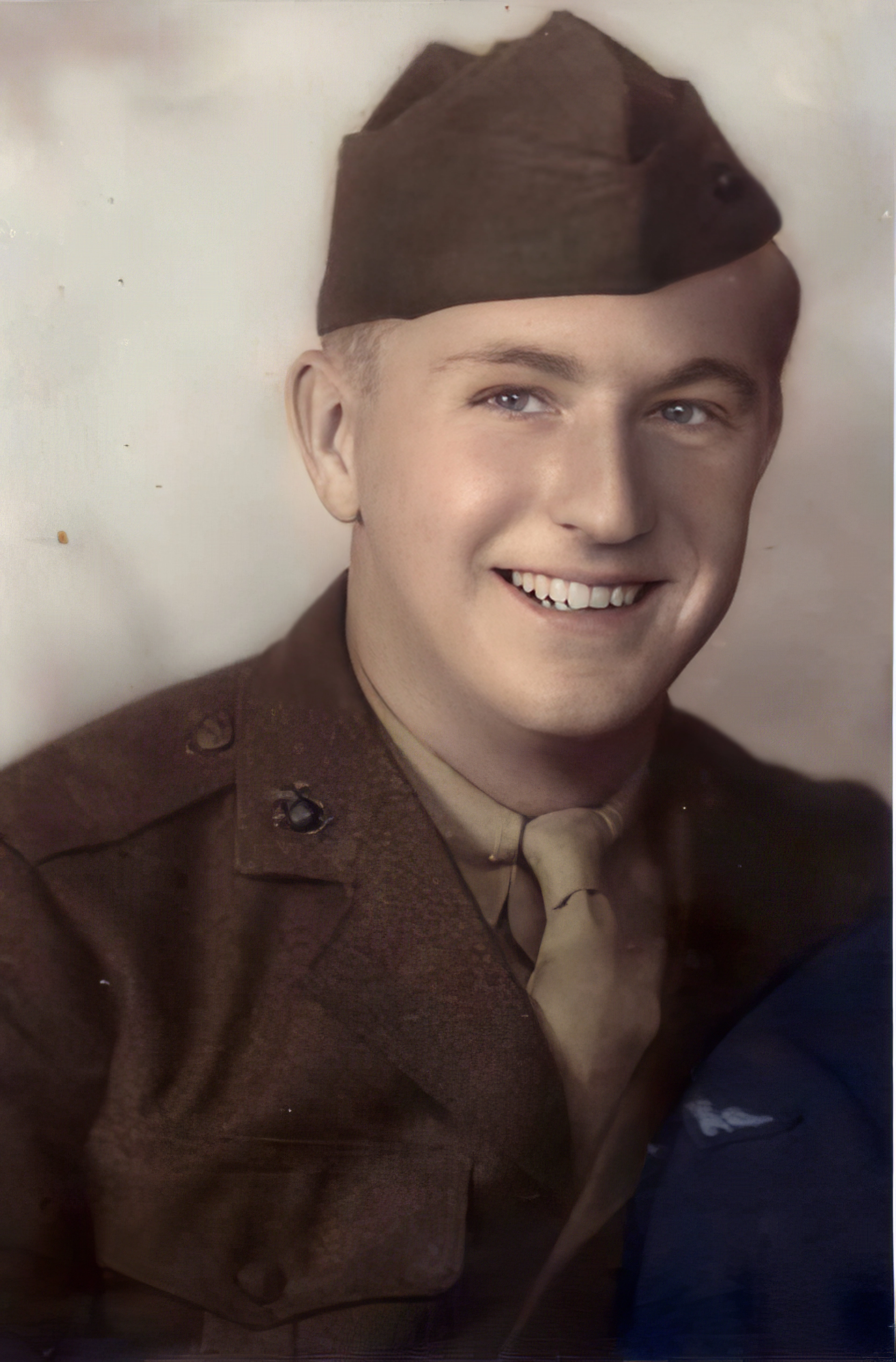
George Peto, Jr., Forward Observer for the 81MM Mortars, 3-1
"Peleliu was a natural fortress. Nowhere in my 32 months of island hopping through the south west pacific did I see anything that could equal it in natural defenses and by the time the enemy put their extra touches to it, it was a formidable obstacle. To this you add 13,000 well-trained and highly motivated Japanese warriors and all hell breaks loose, as the 9,600 marine riflemen found out on D-Day.When you go into the hold of an L.S.T. loaded with 25 amphibian tanks motors running it is like descending into a cloud of gas. I wonder to this day why some of us didn't die of the fumes. One by one the tanks take to the water your relief is short and after a good gulp of fresh air you realize you now have to contend with motion sickness. By the time we lined up to make the run to the beach we all looked like green men from mars, some of the men were up chucking their breakfast. The three-mile ride was slow. The tanks moved slow in the water. The Navy was still firing over us to keep the Japanese holed up until we could get ashore. About one half mile from shore we heard a round go overhead. When we realized this was not friendly fire we hunkered down and the tank driver tried to get more speed up. Soon we hit the coral reef. It felt like we hit a brick wall; water came over the back as we crawled up on the reef to make the final 300 yards to the beach. We were the lucky ones. The water was full of knocked out tanks and men trying to make it to land.
Captain Hunt, K Co C.O., and Lt. Haggerty, PL leader for the 81MM Mortars was in the same tank as was yours truly. My job was forward observer for the 81s. Our tank was not the latest model. It did not have a ramp in back, so we had to go over the side. A 6-foot drop on sharp coral was bad enough, but the Marine following me landed on my back driving me into the coral. After I got my eyeballs focused and back into their sockets, I dove into a tank trap that ran the length of the landing beach. It was full of Marines. One thing that gets drilled into your head is to get off the beach as fast as you can, so I picked up my "rusty-dusty" and moved out. A Marine crawled up to me; he was shot up bad. He said he was a scout and when he went down a small incline the Japanese were buried in the ground with lids over them. After his unit went past, the Japanese cut them to pieces. I was asked to pass the word on, which I did, then went on toward the point.
By now everything was a mess and I was separated from everyone I landed with. Soon I saw Lt. Haggerty and my morale went up a notch. We soon found our communicators Bob Johnson and Danny Sullivan. Things were looking up. We all made it with no injuries and were ready to get on with our jobs. K-Co had the left flank of the regiment. The plan was to advance up the beach and take the anti-boat gun out that was devastating the beach. The gun was in a cove protected by l0 feet of coral on top with trees growing on top, at least 20 year old trees. The only thing visible was a small slit for the gun to shoot through. An unfortunate tank made the mistake to get in front of it. The knocked out tank was still there when I left the island two weeks later.
The 81s lost one gun coming in, but we could not establish contact with them so we could not fire any support for K-Co the first night. Lt. Haggerty asked how we felt about staying with K-Co. and giving them a much-needed hand since we could not do our specialized jobs. We all agreed to help salvage a .30 Cal light machine gun off the disabled tank and two cases of hand grenades. We were on the right end of the Co line. There was no one on our right; we were isolated on the point. Danny and I were both ex-machine gunners so things went well until the tide went out and the enemy came up from behind us, so we were vulnerable on 3 sides. We kept the machine gun humping most of the night. The enemy probed the lines all night. The Army had the longest day but the Marines had the longest night on September 15, 1944.
When the sun came up on the 16th, 18 Marines were left on the point, but over 500 dead warriors surrounded the perimeter from the Japanese Empire."
Norris Thorud Jr., Weapons Co., Anti Tank Support, 1st Marines
"I hit the beach about noon on D Day. What a sight. We waded over bodies on the beach. We got in about 100 yards and came to the airport. Then we saw the enemy tanks coming at us. I counted 23 before they went past us. One tank hit a bomb crater and got stuck. A Marine jumped upon it, opened the turret and dropped a block of TNT in the tank—blew it to bits."CPL Robert L Cover, B-1-1
"Peleliu is 2 miles by 5 miles and had a coral reef extending out from shore about 800 yards. Had to wade some of it to get on beach. Lost most men on landing—the enemy held the high ground—Bloody Nose Ridge. I counted 187 buffalos and gaters knocked out on the coral reef. All from guns on the Ridge. Company B had the left flank of the landing with the ocean on our left. At night the Japes would wade around on the coral shelf and try to get behind us. We put men out on the shelf with bayonets and knives in waist deep water and stopped that nonsense. We landed on September 15. After three days, our outfit of 242 men that landed had 19 men still on their feet."Burnett Napier, B-1-1
"Very few people ever heard of Peleliu. It was overlooked in the new back home. The Island was only five mile long and two mile wide in the widest place and the navy had given itt a tremendous shelling. But the defenses were far beyond anything that had been seen before. There were over 500 caves, some with steel doors and were mutually supporting along with score of concrete pillboxes.As the Amphibious Tanks were carrying the marine over the Coral Reef to the beach, the artillery and mortar came down on us in torrents. Many Amphibs loaded with men received direct hits, knocking them out and killed all aboard. The one I was in made it to the beach. There was chaos. The artillery and mortars were coming down like rain. Dead and wounded were everywhere. We corpsmen really had to put our training to use. I wouldn't hazard a guess as to how many wounded I treated that day, but it was certainly in the dozens. Good men were mangled beyond recognition in many cases. That night, I remember being called from one wounded man to another all night long, never slept a wink and frankly, I doubt a single Marine on the island slept at all.
By the fifth evening, B Company, which had suffered over 80% casualties, was removed from the line and considered unfit for further combat. That evening, while we were off the front line, we really could see the effect of the first three days actions. Enemy bodies were everywhere in a state of advanced decay. The temperature was 110 to 118 degrees. Flies were in swarms over the bodies and maggots were by the bucket full. The stink was awful. You couldn't eat your rations without flies being all over the food. There is really no way I can describe the filth that was everywhere. You couldn't escape it.
The next morning things were so bad on the front that B Company once again received orders to move back to the front. We mustered and found there were 38 of the original company of 240 men. One officer of the original seven and 36 other Marines. I was the only corpsman of the seven who landed."
Ted Reuther, C-1-1
"Making an assault on a heavily defended beach on a landing craft - this one was a Higgins boat - was the most frightening thing I have ever experienced. Bullets and artillery were coming at us from seemingly everywhere. Dead Marines were floating in the water all around us. We could hear the high, windy whistling of the artillery shells about the din of guns and bombs. The landing craft hung up on the coral, the doors opened and we jumped into chest-high water and struggled ashore with bullets and shells zinging in the water all around us.
Our destination was 500 yards inland, but we were pinned on the beach all night in the intense firing. The next day we managed to advance to the worst battle of the island known as Bloody Nose Ridge. The Japanese had taken defensive positions in caves dug into the heights, completely stocked with every provision necessary, and fortified with sliding metal doors for protection. It was a situation that cost many, many lives.
Two hundred twenty mend in my company went into the battle and 15 of us came out. But for my captain, I would have been one of the majority. He called me to his position just as a mortar shell exploded on the spot where I had just been sitting. I received only shrapnel in my back and after treatment at an aide station I returned to the fighting, earning a Purple Heart. For his bravery and leadership, Captain Pope received the Congressional Medal of Honor. He was the only officer in the company left standing."
Our destination was 500 yards inland, but we were pinned on the beach all night in the intense firing. The next day we managed to advance to the worst battle of the island known as Bloody Nose Ridge. The Japanese had taken defensive positions in caves dug into the heights, completely stocked with every provision necessary, and fortified with sliding metal doors for protection. It was a situation that cost many, many lives.
Two hundred twenty mend in my company went into the battle and 15 of us came out. But for my captain, I would have been one of the majority. He called me to his position just as a mortar shell exploded on the spot where I had just been sitting. I received only shrapnel in my back and after treatment at an aide station I returned to the fighting, earning a Purple Heart. For his bravery and leadership, Captain Pope received the Congressional Medal of Honor. He was the only officer in the company left standing."
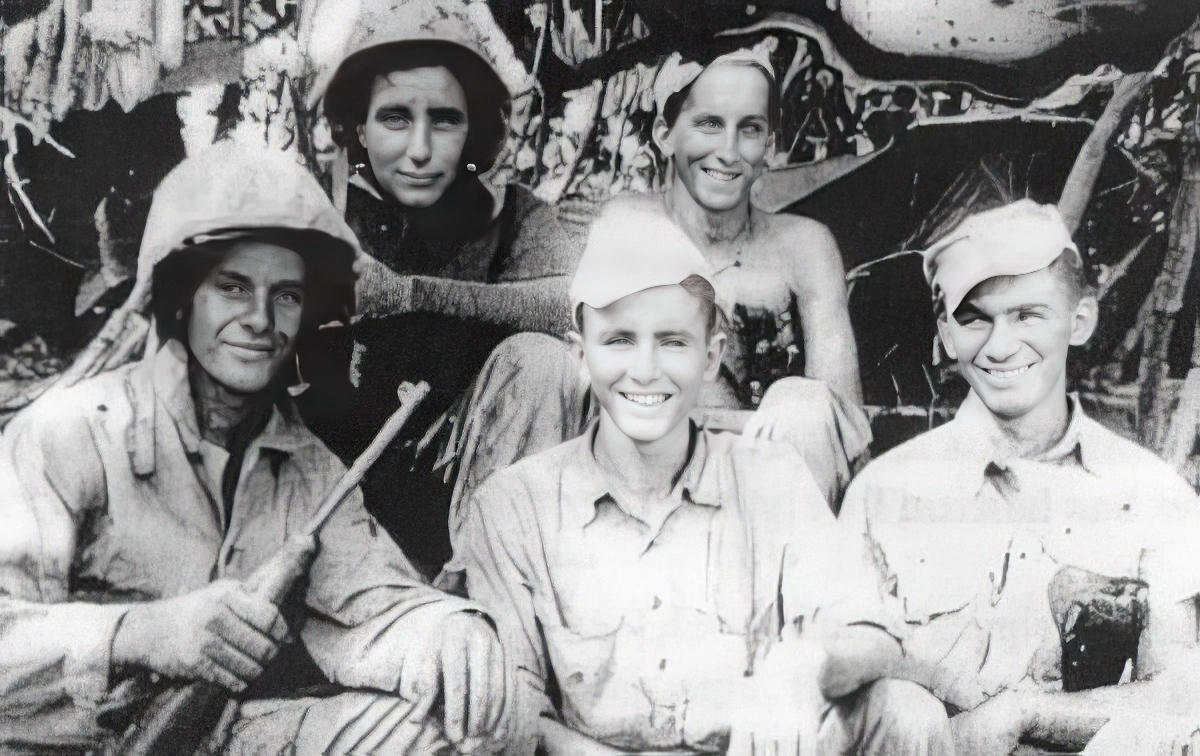
Lugene J. Chesnut, E-2-1
"We started up the ridge and I was standing against a 6 foot high ledge, looking for targets to fire at, when two streams of bullets started hitting the ledge on either side of me. I turned around and there was one of our tanks firing twin guns. The bullets penetrated the coral and did not ricochet. It seemed like hours before one of our men got to the telephone at the read of the tank and had them cease fire. I wasted no time in getting behind the tank.We continued our advance until we were hit by a mortar barrage. One hit behind us, and we all started running forward, when another hit ahead of us. I thought they sure have our range now. I broke to the right. It seemed like everyone ran in a different direction. Another round hit in front of me and I changed direction again. I heard someone calling to us from a cave opening, and I lost no time getting inside. It was a large cave with a fresh water stream running through it. There was a rope bridge across this stream. The cave went back up toward the ridge as far as we could see.
Later, we were ordered to set up a defensive perimeter for the night. We had just dug in when some of the CB's, who were on the LST with us on the trip to the island, found us. They said they had been looking all over for us. They handed out bottles of 4 Roses. I took one big swig and felt a big, warm feeling going down my throat and fanning out from my stomach to all parts of my body. I have never felt anything like that before or since. I sat right down and ate a can of C rations, the first food I had eaten since before Bloody Nose Ridge. We needed the relaxation that the 4 Roses provided. We sure thanked the CB's (what would we have done without them)."
Richard Bruce Watkins, E-2-1
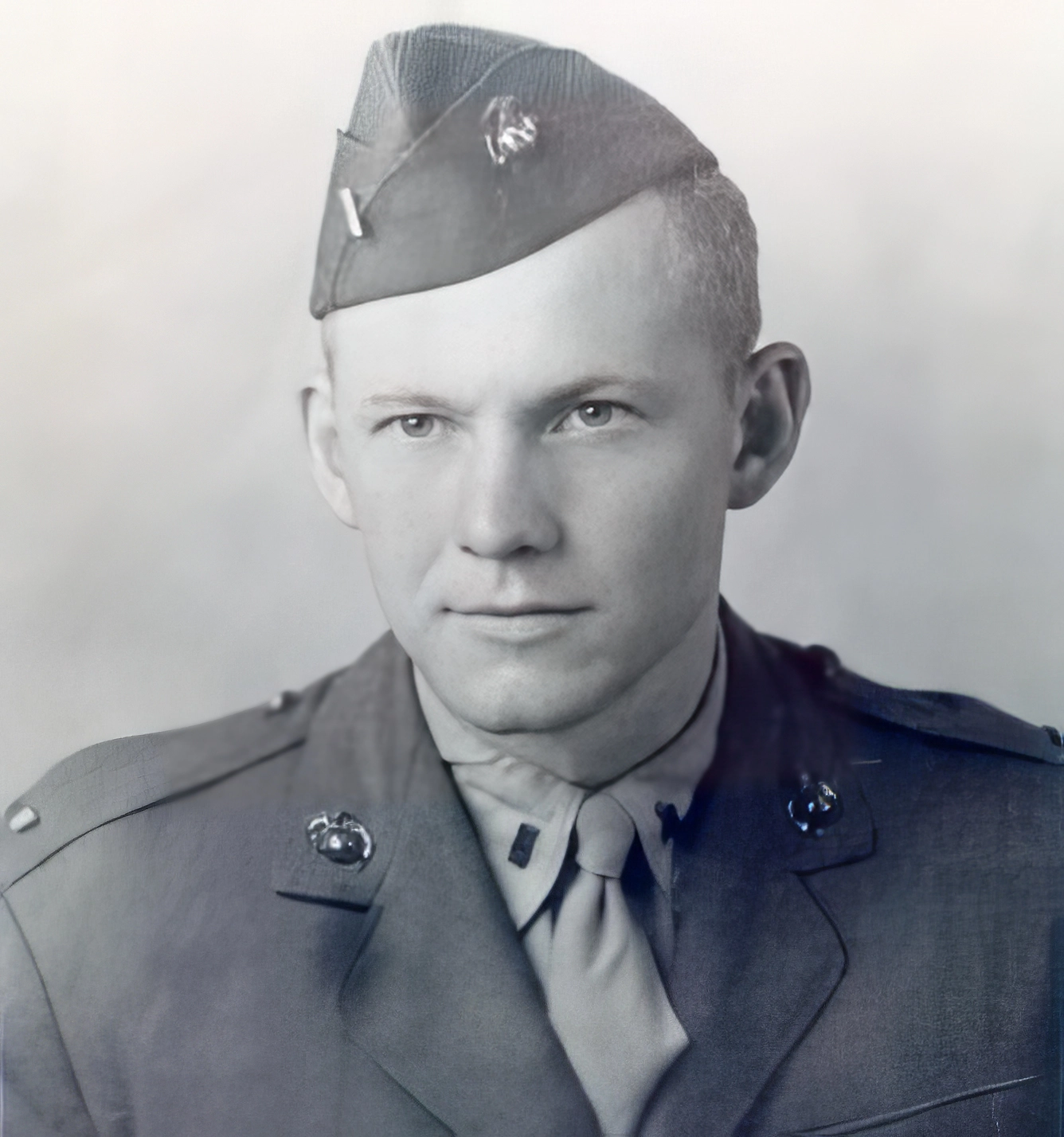
"Around midnight I heard a call for help about five yards to my left front. Even with good fire discipline, it was difficult to move at night without getting shot by our own men. I yelled ahead and repeated the password several times while crawling forward. When I got there, I discovered that it was PFC Bucky Buckner, and he had taken a fatal wound in the abdomen from a mortar fragment. By the light of the almost constant flares, I could see there was little hope. His stomach area was in ruins.
I called for a corpsman and one of those brave Navy men assigned to us crawled up to help. He too knew it was useless, but since Bucky was conscious and in considerable pain, he got out a morphine syrette and gave him a shot. To me he signaled that the best we could do was to make Bucky comfortable as there was no way to get him out. He left me several more syrettes and crawled off to help others.
Left alone, Bucky and I talked as I lay beside him in the foxhole, wincing as every new mortar barrage came in. He was very young, about twenty, but he had a wife and baby and, naturally, they were uppermost in his mind. As his pain go worse, I gave him more morphine. For perhaps two hours he drifted in and out of consciousness.
I tried to catch his fading words and give him what comfort I could. He wanted his wife to know how much he loved her. Finally, he was still. I just hoped that my hand on his was a little comfort toward the last.
[In the morning] As we began to organize our line, I looked down at Bucky's poncho-covered figure. Acting on strong feeling, I discarded by carbine and picked up his rifle. Silently, I promised I would personally get one for him.
Interestingly enough, I received a bill for this same carbine plus binoculars and a map case some six months after the war ended. Some peace time soldier was following the book, and I took great pleasure in describing to Headquarters where each item was last seen on Peleliu."
I called for a corpsman and one of those brave Navy men assigned to us crawled up to help. He too knew it was useless, but since Bucky was conscious and in considerable pain, he got out a morphine syrette and gave him a shot. To me he signaled that the best we could do was to make Bucky comfortable as there was no way to get him out. He left me several more syrettes and crawled off to help others.
Left alone, Bucky and I talked as I lay beside him in the foxhole, wincing as every new mortar barrage came in. He was very young, about twenty, but he had a wife and baby and, naturally, they were uppermost in his mind. As his pain go worse, I gave him more morphine. For perhaps two hours he drifted in and out of consciousness.
I tried to catch his fading words and give him what comfort I could. He wanted his wife to know how much he loved her. Finally, he was still. I just hoped that my hand on his was a little comfort toward the last.
[In the morning] As we began to organize our line, I looked down at Bucky's poncho-covered figure. Acting on strong feeling, I discarded by carbine and picked up his rifle. Silently, I promised I would personally get one for him.
Interestingly enough, I received a bill for this same carbine plus binoculars and a map case some six months after the war ended. Some peace time soldier was following the book, and I took great pleasure in describing to Headquarters where each item was last seen on Peleliu."
Isidore Jerry Fessler, F-2-1
(as told by Jerry's grandson): "Jerry was at the invasion of Peleliu were he was wounded in action at the Airport. My Grandfather was decorated with the Navy Cross for his heroism for defending his position and destroying three enemy tanks, loading and firing on his own until he was shot twice in the middle of the airport. Jerry Platoon leader was 1st. LT Joe Cassidy who witnessed my Grandfathers heroism in action."Al "Duke" Dellaera, I-3-1
"I recall, on that morning of September 15, 1944 , looking over the side of the LST towards where you would find Peleliu and seeing nothing but heavy black smoke and flame. Not a bit of land could I make out. The naval barrage and the napalm dropped from our air support was intense.As the 3rd Battalion 1st made its approach, K company and elements of I company landing craft drifted left away from the main body (can't explain why this happened). When we hit the beach, the drift caused a wide gap in the line. We landed in the area of a promontory described, later, as 'The Point', with Japanese confronting us on the left, the front, the right and the sea behind us. Separated from regiment and division, we held our own private war with the Japanese.
After some 30 hours or so, the regiment succeeded in closing the gap. The 'Point' had been secured but it was costly in marines wounded and killed. Now, late on day 2, I was able to rejoin the company. I got a warm reception, I had been written off as either killed or wounded. When I met up with them, the company was about to launch another assault. I arrived in time to join in the action and to get cut down. I felt as if I had been hit with a baseball bat, not a sharp pain but a numbing pain.
I don't know how long I lay where I went down. It was dark when I regained consciousness. It was very quiet, not a sound, until I heard some one or some thing moving about. I could only think it might be the enemy looking to do in a wounded marine. I was scared shitless. Then, I heard a voice whisper my name and asking if I was alright. It was a marine from my platoon. He had seen me go down and, when the assault ended and it was quiet, he crawled out on his stomach looking for me. When he found me, he took hold of my backpack and crawled back to our line dragging me behind him.
It was years later that I learned who that marine was and was honored to meet him and his family. He has passed on now. His name was Bertram 'Bert' Dugan from Athol , Massachusetts . A true hero, 'unsung', deserving of a Silver Star. In the tradition of the Corps., he wasn't about to leave a marine behind. He risked his life on the chance that he could save mine. I had lost a considerable amount of blood and I might not have lasted the night, my wounds that severe. It was 2 years later that I was released from the Naval Hospital at St. Albans , NY and discharged from the Corps."
Richard A. Correll, K-3-1
"We boarded LSTT227 and made a landing at 8:30 AM September 15, 1944 to capture the point (Bloody Nose Ridge). That was our main objective. I recall Capt. Hunt took a roll call that same day around 4 PM and counted 75 men left standing out of our company. It was a terrible day."PFC Jackson M. Douthit, L-3-1
"I was wounded twice on Peleliu. Shot through the lung on Bloody Nose Ridge. Before I could go back to the lines, I was hit by fragment from a hand grenade. I was in the hospital, but returned for Okinawa where I was wounded 3 more times.We lost a lot of good men on Peleliu."
Company A, 1st Engineer Battalion
No veterans have submitted recollections.Company A, 1st Medical Battalion
No veterans have submitted recollections.Company A, 1st Pioneer Battalion
No veterans have submitted recollections.Company A, 1st Tank Battalion
No veterans have submitted recollections.Cpl John "Jack" F. Naut, USMCR, A Company, 1st Tank Battalion
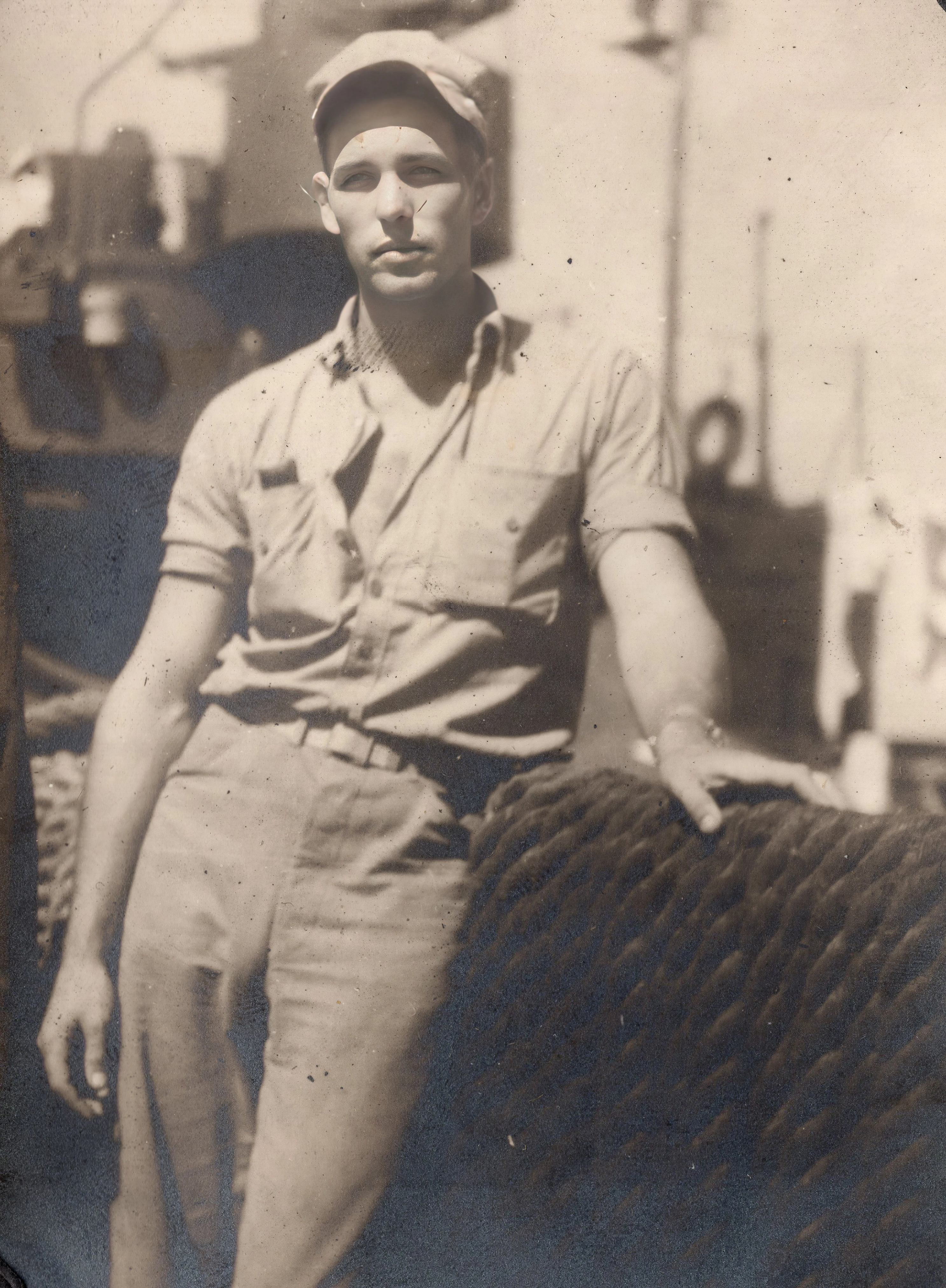
[A couple of days after Japan's surrender and while aboard LSM 85 headed to Tangku, China from Okinawa, he wrote his only letter home from the war where he recalls his first battle in Peleliu] "Around August 1, we shoved off for Guadalcanal (the staging area) and went from there to Peleliu, where we made the beachhead at 0820 hours on 15 September. From then until the end of October were the worst days of my life. I could never explain that hell – it just seemed like a nightmare."
Jack never spoke a word to anyone in his family about his experiences as a Marine and he passed away in 1982. All that was left behind was a blood stained Rising Sun flag and an impressive photo album from his time in Peleliu, Okinawa, and China.
His grandson, Col Mike Livingston, USMC (Retd) would love to hear from any of his 1st Tank Battalion friends or their families: livingston1999@gmail.com.
Jack never spoke a word to anyone in his family about his experiences as a Marine and he passed away in 1982. All that was left behind was a blood stained Rising Sun flag and an impressive photo album from his time in Peleliu, Okinawa, and China.
His grandson, Col Mike Livingston, USMC (Retd) would love to hear from any of his 1st Tank Battalion friends or their families: livingston1999@gmail.com.
1st Platoon, 1st MP Company
No veterans have submitted recollections.1st Platoon, Ordinance Company, 1st Service Battalion
No veterans have submitted recollections.Detachment, Service and Supply Company, 1st Service Battalion
No veterans have submitted recollections.Detachment, 4th Joint Assault Signal Company
1st Lieutenant Quentin 'Monk' Meyer, 4th Jasco
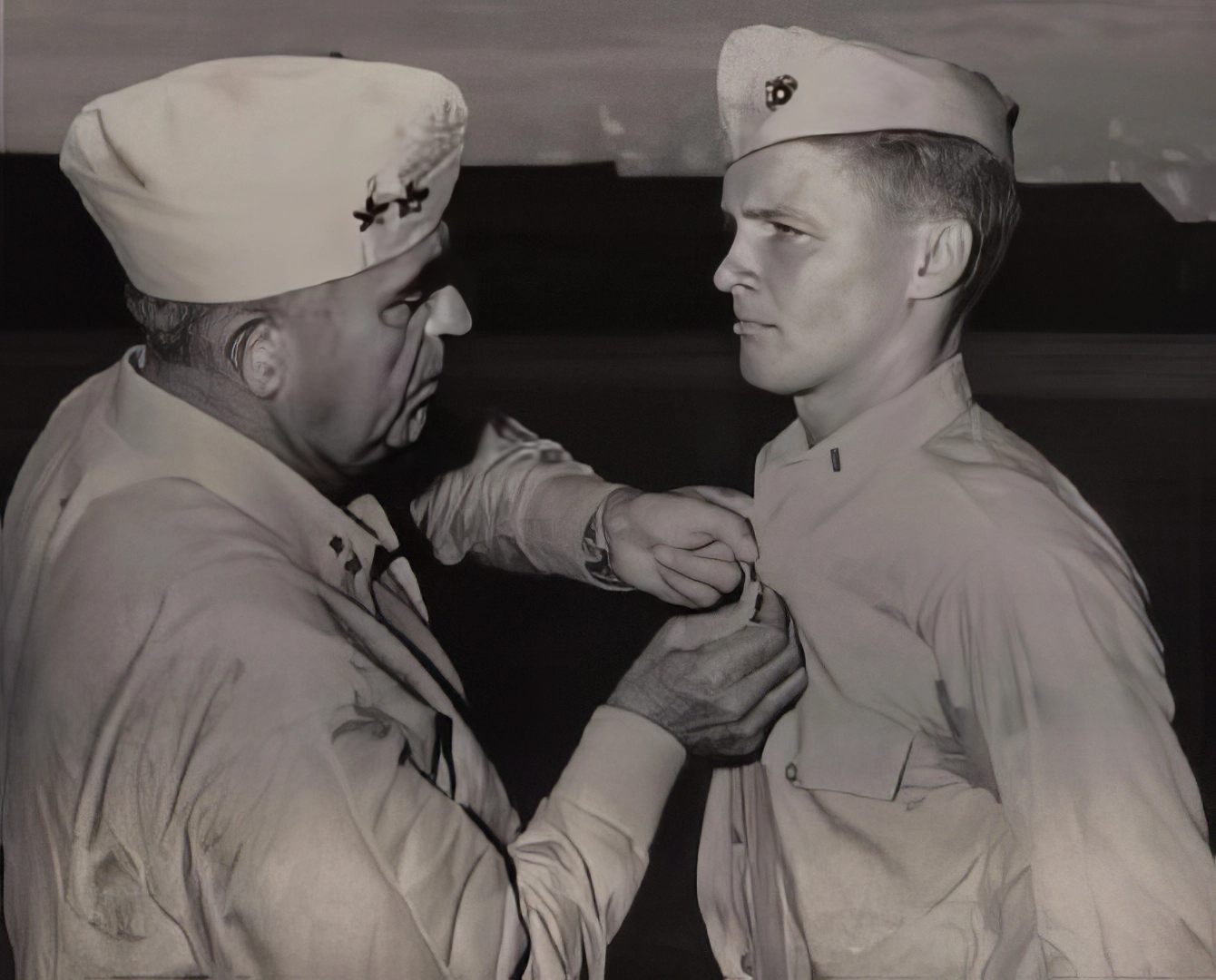
(as told by his niece, Holly Beyer): "My uncle was with the 4th JASCO attached to the 1st Regiment 3rd Battalion. He was awarded the silver star for finding Capt. George Hunt and taking a long swim around the point to report back the C.P.. Later, he was KIA on Okinawa near the southern end of the Island near Shuri May 11,1945 in which he was awarded the Purple Heart. He also was decorated with the Presidential Unit Citation and the Pacific Asiatic Theater Award."
(as written in a letter home): "I haven't told you about my amazing meeting with my brother Peter. On the fifth or sixth day I was standing up to my waist in water spotting the naval gunfire when I heard a "Hello, Monk" behind me - turned around muttered "Hello" and went back to my work - just failed to register - when the light dawned , almost dropped my field glasses and map in the water - I had no idea that his outfit was in anyway connected with the operation - apparantly they were being used as stretcher bearers - greatly needed. I was so surprised and glad to see him that it was some time before I realized that this was no place for him to be - we were up slightly in front of the lines and there happened to be some sniper fire - well I told him to get the hell back but with no effect - he stayed for two days and was a great help as I happened to be short handed. Thank God it wasn't too hot at the time - the last I saw him he was wading back thru the water - I put a call thru to him when we were relieved and he's O.K. - his outfit is going to garrison the Island when we leave. Isn't that amazing though,darling. Of all the times and of all the places.".
(as written in a letter home): "I haven't told you about my amazing meeting with my brother Peter. On the fifth or sixth day I was standing up to my waist in water spotting the naval gunfire when I heard a "Hello, Monk" behind me - turned around muttered "Hello" and went back to my work - just failed to register - when the light dawned , almost dropped my field glasses and map in the water - I had no idea that his outfit was in anyway connected with the operation - apparantly they were being used as stretcher bearers - greatly needed. I was so surprised and glad to see him that it was some time before I realized that this was no place for him to be - we were up slightly in front of the lines and there happened to be some sniper fire - well I told him to get the hell back but with no effect - he stayed for two days and was a great help as I happened to be short handed. Thank God it wasn't too hot at the time - the last I saw him he was wading back thru the water - I put a call thru to him when we were relieved and he's O.K. - his outfit is going to garrison the Island when we leave. Isn't that amazing though,darling. Of all the times and of all the places.".